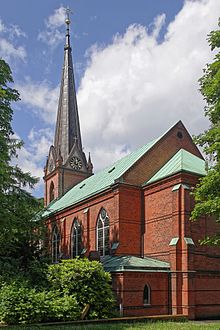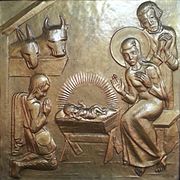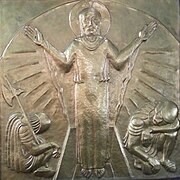St. Nicolaus (Hamburg-Alsterdorf)
The Evangelical Lutheran Church of St. Nicolaus in the Hamburg district of Alsterdorf is located on the grounds of the Alsterdorf Evangelical Foundation directly on Sengelmannstrasse.
Church building
The Church of St. Nicolaus has a checkered history as an institutional church of the Alsterdorfer Anstalten founded by Pastor Heinrich Sengelmann . While Sengelmann was still alive, it was built in 1889 in neo-Gothic style by the architect Gustav Otte . (This was preceded by a three-way competition with Julius Faulwasser, among others ). It is one of the last remaining historical buildings of the former Alsterdorfer Anstalten . The floor plan and a cross-sectional drawing were shown in "Hamburg and its buildings", Volume 1 as early as 1890. The total length of the church is about 31 meters and the width is about 16.5 meters.
At times it was the church of the former " Evangelical Lutheran Church in the Hamburg State " and the subsequent " North Elbian Church " for the Alsterdorf district.
- Before the 1938 redesign
There are two photos of the interior of the church from the first 75 years: The photo from before 1908 shows the church interior with an Art Nouveau decoration made of tendril garlands and some text cartouches . A more recent picture, which must have been taken after the First World War because there was already a 'plaque of honor' for the fallen to the left of the chancel, shows the central glass window above the altar more clearly, from which the pictured photo Cutout is taken. This was done according to designs by the young artist Melchior Lechter .
Renovation in 1938
The renovation, which was carried out by the architects Hopp and Jäger for the 75th anniversary , included a renewal of the organ and gallery, the side windows and the removal of the surrounding plinth - and instead painting it with a simple white paint - also a renewal of the Tribute to the fallen in the redesigned vestibule, the pulpit, the baptismal font and the altar were carried out by them. In addition, the chancel was completely redesigned by closing the east wall and replacing the defective chancel window and placing a large mural with a crucifix on it.
Interior
Chancel mural
In an incompletely preserved draft drawing - titled “Redesign interior proposal 2 Hamburg the 18th III. 1936 Arch. H. Distel / A. Grubitz ”, a large-scale depiction of a cross had already been considered at this point. Presumably because of a plane crash and other financial and construction needs, however, this project has not yet been implemented, but only with the above. Renovation. This mural has provoked controversy - especially in the years after 1987 - so that since then different interpretations have faced each other.
In addition to the central depiction of the crucified, the photo from 1938 reveals the formal design of several groups of figures:
"A. In the upper area around the cross, the aforementioned spirit dove can be made out as well as the angelic figures representing the heavenly world - two each on the left and two on the right; the coloring means they are less emphasized as a 'background';
b. in the area of the 'foreground' visible below, to the right of the cross, a group of five people is positioned around the figure of the institution's founder, H. Sengelmann, which Alsterdorfer can be sure of due to the almost photographic representation;
c. Another group in the 'foreground', standing close together from the left side of the cross - at a slightly distant and curved angle to below the cross - comprises eight people; Martin Luther as a monk with tonsure can also be clearly identified by using a picture template in the extreme left corner of the corner;
d. as an extension of the legs of the 'lower angle part' of the eight people - but somewhat separated by a space - there are two more people in the right part of the foreground: one of them is clearly shown as disabled due to the design without his own clothes and in association with the companion ; Due to the positioning in relation to group c) and on the right side of the picture also below group b), there is a special assignment to both. "
In groups (b) and (d), problems of interpretation are posed by those people who are shown without a 'halo'. In the 'Sengelmann group' (b) there is a toddler and an adolescent boy at Sengelsmann's side. For both of them, the picture shows no obstruction whatsoever, so that such a common background is ruled out as the reason for the 'without halo' representation.
Since 1987, however, the opposite of 12 people 'with a halo' to the three 'without' has been associated with people's values and these three have been interpreted as people with disabilities without justification. Since the Nazi murders of " euthanasia " committed against Alsterdorf residents during the war were rightly denounced from this time on , this interpretation has found a certain level of acceptance. On the other hand, this interpretation is also connected with the problems mentioned and other problems, because several more questionable things are also assumed:
- The 1938 picture was created several years before the witnessed murders of over 600 people with disabilities from Alsterdorf;
- the representation of Christ depicts an “Aryan” Jesus (see Evangelical Foundation Alsterdorf # mural of the Aryan Christ ) and downright a muscle man, as it is called on the Alsterdorf website and in some documents;
- the picture was made by the head of the institution at the time, Friedrich Lensch . In the depiction without a halo (= 'unworthy of life'), he had expressed his later decision to report people, some of whom were transported to other institutions, years earlier.
However, from another point of view, these historical assignments are unsustainable and do not take into account all available contemporary source information.
- For the renovation of the church, Pastor Lensch specifically referred to the work of the architects Hopp and Jäger. Given the knowledge of Hopp's artistic training, as well as his designs and designs for other churches, it is more likely that the essential elements of the portrayal were designed by Hopp. However, Lensch also designed details (mainly some of the facial depictions) himself. Already the production of templates for a design - covering the large wall surface - which was transferred in the correct proportions for execution, would not be expected from Lensch. Hopp, however, had already z. B. In 1924 when the city hall was painted, the ceiling of the wedding hall was painted . He was a trained decorative painter.
- The assumption that an “Aryan” Jesus is depicted cannot be verified by comparison with similar depictions.
- The explanation of the differentiated representation - with and without a halo - is not to be understood in such a way that disabled people could never be represented 'with'. Rather, confirmation played a decisive role for admission to the altar sacrament at that time. The three people without a halo are those who are not confirmed: a toddler, a boy and one depicted as severely disabled. According to the idea of the time, only those who partake of the Lord's Supper belonged to the 'community of saints', as the Creed put it, in union with the heavenly. In this respect, four angel figures around the cross and a dove with a halo above are depicted in the altarpiece in group (a) as a background, which interprets and illustrates both the third article of the Creed and the sacrament liturgy. If a distinction is expressed through the image, it is admission to the Lord's Supper, which was then subject to different conditions than was the case in the decades from the 1970s onwards. The sermon and interpretation of the “halo” by Pastor Lensch in 1938 formulated the appreciation of the handicapped people entrusted to them and an explicit demarcation from “euthanasia” thinking. The text was published in 1938, which at the time can be judged as a courageous statement against the official Nazi view and does not correspond to the opposite view described above and spread from 1987 onwards.
The confirmation of those handicapped people who were able to take up the relevant instruction is regularly attested in the “Letters and Pictures from Alsterdorf” for the Sunday Palmarum from 1933 onwards. Your authorization to admit the Lord's Supper was thus given. It cannot be ruled out that some of the younger people on the altarpiece with a halo represent such confirmed members of the congregation.
New altarpiece
One element of the redesign of the altar is related to the special importance of the confirmation Sunday Palmarum . During the renovation in 1938, he received an essay that was created by the metal sculptor Eva Dittrich . For five church feast days, in consultation with Bernhard Hopp, she drove scenes of biblical motifs into thin copper sheet reliefs. This series of festivities begins with the entry of Jesus into Jerusalem , as a picture of the altar from 1938 shows. Christmas, Easter, Ascension and Pentecost follow in the order of the New Testament narratives. This corresponds to the pericope order in which at the beginning of the church year , on the 1st Sunday of Advent , Matthew 21 : 1-9 LUT is read as the gospel text. this is to emphasize the meaning of Advent = arrival of Jesus. The same gospel reading is assigned to Palm Sunday.
- Pulpit reliefs by Eva Dittrich in the St. Nicolaus Church of the Alsterdorfer Anstalten
Church remodeling
The celebration of the Lord's Supper in Protestant churches has undergone a change both legally (since the 1970s) and in practice that younger people are hardly aware of - and that has led to changes in numerous churches. The only prerequisite for participating in the Lord's Supper is baptism, and in many cases new forms are practiced which have the character of a common gathering around the altar as the 'Lord's table'. In St. Nicolaus, the slightly raised and bricked altar by a step around it has been replaced by a mobile table. The previously practiced registration was omitted. The five former altar reliefs were placed on the cassettes of the pulpit, the chronological order being 'corrected' according to the church year , so that the Christmas picture now starts from left to right.
Due to the interpretation of the altar mural, several attempts have been made to change the visibility that defines the space. A first attempt to cover the mural with a curtain was abandoned. The building committee of the North Elbe Church determined on the one hand that the ensemble from 1938 should be preserved, but that the spatial weighting could possibly be re-weighted through an alternative work of art. However, the metal sculpture created by Klaus-Jürgen Luckey , which depicts Christ carrying the cross on his ordeal in the legendary encounter with Veronica and her handkerchief , did not meet these expectations. The third attempt at an optical refraction by a work of art by a disabled artist shows the diversity of the universe in the foreground and only allows a broken view of the mural from the room.
One of the declared goals of the Alsterdorf Evangelical Foundation is to completely remove the mural in the listed building. It is still unclear whether the work of art, whose author has died less than 70 years ago, may be removed. The planned removal of the pulpit with the reliefs by Eva Dittrich is subject to similar legal issues.
organ
In 1866, an organ that had previously played in the Jakobuskirche in Brunsbüttel until 1863 was moved to the predecessor chapel of St. Nicolauskirche. This instrument, acquired from the Jakobuskirche in Brunsbüttel from a still enigmatic Mr. Hans Jürgen Pape for 500 mk (it was not the Stellwagen organ from the Glücksstädter Schlosskapelle!) Was sold to the Hamburg St. Jacobi with the construction of the St. Nicolauskirche. Community sold. The richly decorated baroque prospectus served as the basis for a new instrument for their chapel, built in 1860 on the new St. Jacobi cemetery in Eilbek (later the Easter church in Hamburg-Eilbek ). In 1895 Ernst Röver built a new building in the new St. Nicolauskirche, which was expanded by three registers in 1930/1935 by an unknown organ builder . Emanuel Kemper & Sohn carried out a renovation in 1952. Today's organ dates from 1963 and was made by Walcker & Cie. built as opus 4461 and renovated and rebuilt in 1989 by Claus Sebastian. The instrument has 25 registers, which are distributed over three manuals and pedal . Game and stop actions are mechanical. The disposition is:
|
|
|
|
||||||||||||||||||||||||||||||||||||||||||||||||||||||||||||||||
- Coupling : I / II, III / I, I / P, II / P, III / P
location
Coordinates: 53 ° 36 '46.8 " N , 10 ° 1' 18.8" E
literature
- Ralf Lange: Architecture in Hamburg . Junius Verlag, Hamburg 2008, ISBN 978-3-88506-586-9 , p. 234 .
- Uwe Gleßmer / Alfred Lampe: Church building in the Alsterdorfer Anstalten: The redesign of St. Nicolauskirche, Friedrich K. Lensch (1898–1976) and interpretations of the altar mural . 2nd corrected and enlarged edition. Books on Demand , Norderstedt 2016, ISBN 978-3-7392-1298-2 .
- Uwe Gleßmer / Alfred Lampe: Mit-Leiden in Alsterdorf and his historical pictures of the institutions . Books on Demand , Norderstedt 2019, ISBN 978-3-7504-0860-9 .
Web links
Individual evidence
- ↑ In “Pictures from the Alsterdorfer Anstalten” (1908) p. 7, panel II, image 4, digitized URL = http://resolver.sub.uni-hamburg.de/goobi/PPN77000069X .
- ↑ Alsterdorfer Anstalten in Wort und Bild (1932) p. 37 Digitalisat http://resolver.sub.uni-hamburg.de/goobi/PPN657029246 .
- ↑ On the content and in particular on the angels in the rosette above the depiction of Jesus blessing children, see Gleßmer / Lampe (2019) p. 236ff.
- ↑ see Lensch, Friedrich: Der Leib des Menschen und das Christianentum.- in: Hamburgische Kirchenzeitung (1936) pp. 137–138 Hamburgische Kirchenzeitung 1936. Retrieved on February 18, 2020 .
- ↑ Photo of the chancel. In: huj-projekt.de (church buildings by a Hamburg architecture firm (1930 to 1962/80)). Retrieved February 12, 2020 .
- ↑ Gleßmer / Lampe (2019) p. 115.
- ↑ This probably indicates the death of his son Gustav after eight months and that of his first wife, Adele Sengelmann; see Gleßmer / Lampe (2019) p. 121; there also to the childless second marriage with Jane Elisabeth Sengelmann.
- ↑ Statement of the psychologist Michael Wunder , quoted from Ursula Storost: Psychiatrie im Nationalozialismus. In: Deutschlandfunk . November 25, 2010, accessed February 12, 2020 .
- ↑ See e.g. B. in Stefanie Endlich, Monica Geyler-von Bernus, Beate Rossié (eds.): Christian cross and swastika . Metropol Verlag, Berlin 2008, ISBN 978-3-940938-12-1 , pp. 102 f . This view is presented in detail there. "Pastor Friedrich Lensch personally" is referred to as the author of the picture and it is claimed that "three of the portrayed [...] are recognizable as people with disabilities". In fact, two of the people without a halo are clearly children.
- ↑ The only evidence that Lensch was involved in the design of the picture comes from the diary notes of Hopp, who noted on one of the days of his numerous stays at the construction site on September 22, 1938: "P. Lensch is busy with the picture ”; see Gleßmer / Lampe, 2016, ISBN 978-3-7392-1298-2 , p. 122. A more detailed description of the two authors is available in 2019 under ISBN 978-3-7504-0860-9 as part of the Hopp-und-Jäger- Project (see there also as PDF ).
- ↑ Similar altar wall paintings with a crucifix designed by Hopp are available for the Maria Magdalenen Church (1938) and for the Johanneskirche in Pötrau bei Büchen (1953), without the idea of an "Aryan" appearance of the crucified being here as Criticism documented - or would be reasonably justified by art-historical style elements. The references to the representation as a "muscle man" are unfounded.
- ↑ Instructive is the view that Pastor Paul Stritter (and predecessor of P. Lensch) , who followed Pastor Sengelmann, presented at a congress in 1910 under the title “The Confirmation of Insane People”. Source from upload: Paul Stritter: The confirmation of morons . [Special print: Conference lecture by Director Pastor Stritter]. Norden 1910. - Not so detailed, but correspondingly in terms of content, he presents the problem of confirmation - participation in the Lord's Supper in Stritter (1930) SB p. 13 (upload).
- ↑ Letters and pictures from Alsterdorf 1938 anniversary report huj-projekt.de PDF
- ↑ cf. on the reactions of the local group and district leaders of the NSDAP in Gleßmer / Lampe (2019) p. 132 as well as the corresponding document (from StAHH 213-12_0013 Volume 071, p. 125f.
- ↑ The booklets are available (with increasing year numbers) starting at the address huj-projekt.de/downloads/Briefe_u_Bilder_aus_Alsterdorf_1933.pdf until 1937 as well as for 1931f and a first booklet “… 1938-1_Zum_75j.pdf”.
- ↑ Günter Seggermann, Alexander Steinhilber, Hans-Jürgen Wulf: The organs in Hamburg . Ludwig, Kiel 2019, ISBN 978-3-86935-366-1 , pp. 153 .
- ↑ organ of St. Nicholas orgbase.nl; accessed on February 1, 2017.








